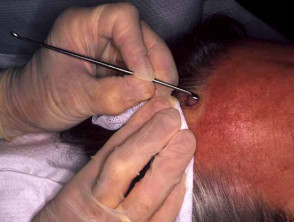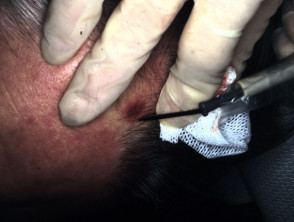What is curettage and cautery?
Curettage and cautery is a type of electrosurgery in which a skin lesion is scraped off and heat is applied to the skin surface.
What is involved in curettage and cautery?
Your doctor will explain to you why your skin lesion needs treatment and the procedure involved. You may have to sign a consent form to indicate that you consent to the surgical procedure. Tell your doctor if you are taking any medication, or if you have any allergies or medical conditions.
The doctor will inject some local anaesthetic into the area surrounding the lesion to be treated. This will make the skin go numb so no pain should be felt during the procedure. You may feel a pushing sensation but this should not be painful. The skin lesion is scraped off with a curette, which is like a small spoon with very sharp edges.
Curettage and electrosurgery
The lesion should be sent to a pathology laboratory for analysis. The wound surface is then cauterised with a hot wire beaded tip or electrosurgical unit (diathermy). This stops bleeding and helps destroys any remaining skin tumour cells.
This procedure is usually repeated twice for malignant skin lesions (serial curettage and cautery).
A dressing may be applied and instructions should be given on how to care for your wound.
What types of skin lesions can be treated by curettage?
Curettage is suitable to treat lesions where the material being scraped off is softer than the surrounding skin or when there is a natural cleavage plane between the lesion and the surrounding normal tissue. The following can often be treated by curettage:
- Seborrheic keratoses
- Viral warts
- Squamous cell carcinoma in situ
- Pyogenic granuloma
- Actinic keratoses
- Basal cell carcinomas
- Keratoacanthoma
- Skin tags.
Basal cell carcinomas that are large, deep or recurrent are usually not suitable for curettage. Lesions with poorly defined edges are also generally unsuitable.
Will I have a scar?
Curettage often results in some sort of scar especially if accompanied by cautery.
The scars from curettage are usually flat and round. They are a similar size to that of the original skin lesion. Some people have an abnormal response to skin healing and these people may get larger scars than usual (keloids and hypertrophic scarring).
How do I look after the wound following skin curettage?
The wound may be tender when the local anaesthetic wears off.
- Leave the dressing in place for 24 hours or as advised by your doctor. Avoid strenuous exertion and stretching of the area.
- If there is any bleeding, press on the wound firmly with a folded towel without looking at it for 20 minutes. If it is still bleeding after this time, seek medical attention.
Keep the wound dry for 48 hours. You can then gently wash and dry the wound. If the wound becomes red or very painful, consult your doctor. There are no stitches to remove after curettage.
The wound from curettage will take approximately 2–3 weeks to heal over. The scar will initially be red and raised but usually reduces in colour and size over several months.

